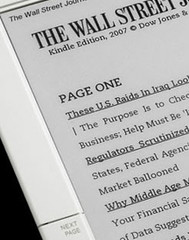
As a foreshadow toward a possible yet uncertain future, two newspapers — The Wall Street Journal and The New York Times — carried stories that mark the sign of the times.
The Washington Post featured an article highlighting the public struggles of the Boston Globe, which many expect could close in as little as 60 days. Meanwhile, The New York Times asked its readership if big-screen e-readers might save newspapers. Some of the new models, which are expected to be released by the end of the year, are coming much closer to electronic paper as imagined more than 35 years ago (and imagined in the fictional world of Harry Potter).
Newspapers And Other Content At The Edge Of A Chasm
For several years, the most pragmatic viewpoint about newspapers has been that they might be dying but news is thriving. Indeed, the problems faced by newspapers have been confined to one of distribution and economics.
Subscription-based content on a more portable e-reader might be the answer, provided newspapers learn to segment their free online vs. subscription-based publications. Content duplication has clearly hastened the demise of print.
The analogy is simple enough. Journalism will survive and leap forward to the other side. So the real question is what will we find once we get there. That is a toss up. While most people focus on the short term, asking whether newspapers will shift toward more localized reporting with an influx of citizen journalists or more relaxed professionals, the real challenge remains content oversight.
In 2007, we asked that question with the advent of the Kindle, already recognizing that the Internet solution-providers were starting to ask questions as to how much content control they wanted as distribution platforms. At the time, people laughed to think Amazon or anyone would attempt to control content. It's not in their nature, proponents said.
Not everyone is laughing now. Apple rejected an update of the Nine Inch Nails iPhone update, saying that it contains “objectionable content.” YouTube, as if in defiance of What Would Google Do? by Jeff Jarvis, is hoping to police product placement, thereby collecting a cut from certain content creators.
The Leap Is Simple Provided People Keep Their Senses
To be fair, it's new territory for everybody. And sometimes, future solutions are easier to come by than the vision of the people shaping it today.
What Could Google Do? Simple. Stick to what it knows best — developing great distribution platforms. And rather than worry about product placement, it might consider a tiered approach to bandwidth with premium video being streamed for a monthly content creator rate. For everyone else, free as always.
What Could Apple Do? Rather than reject material based upon questionable content, it might consider opening a separate section for adults. And no, we don't mean an electronic version of the original local video store. Rather, something like NIN can stick to creating content.
What Could Newspapers Do? Really, if the problem is distribution because printed products are too expensive, then it's well past time to partner with electronic paper makers. Some people might be willing to pay a modest rate for subscription service to some papers for delivery by application or e-reader. Just keep the price models in check. Almost everyone knows that subscription fees never really paid for print (so split the subscription with the distributor or whatever); advertising did.


















